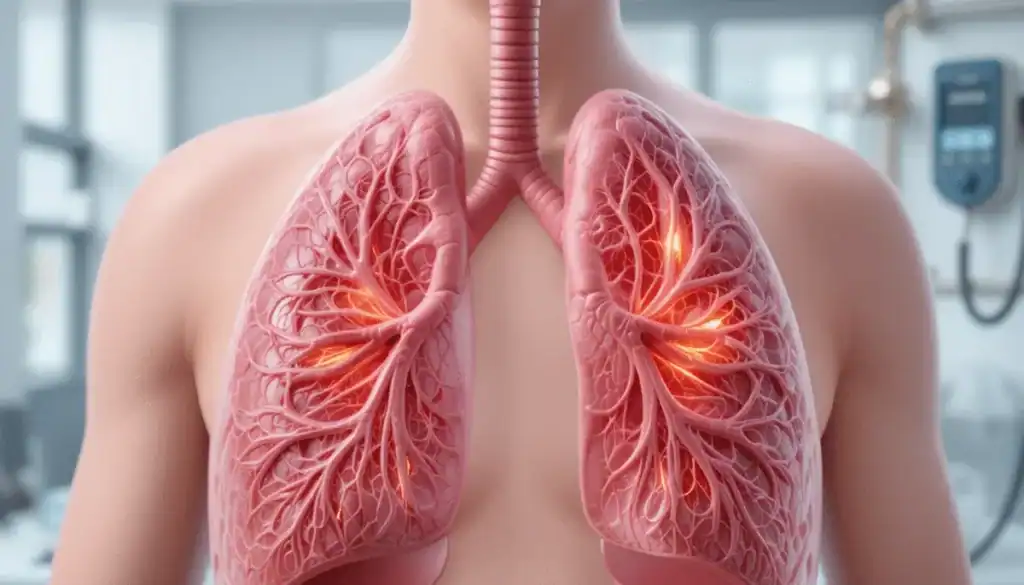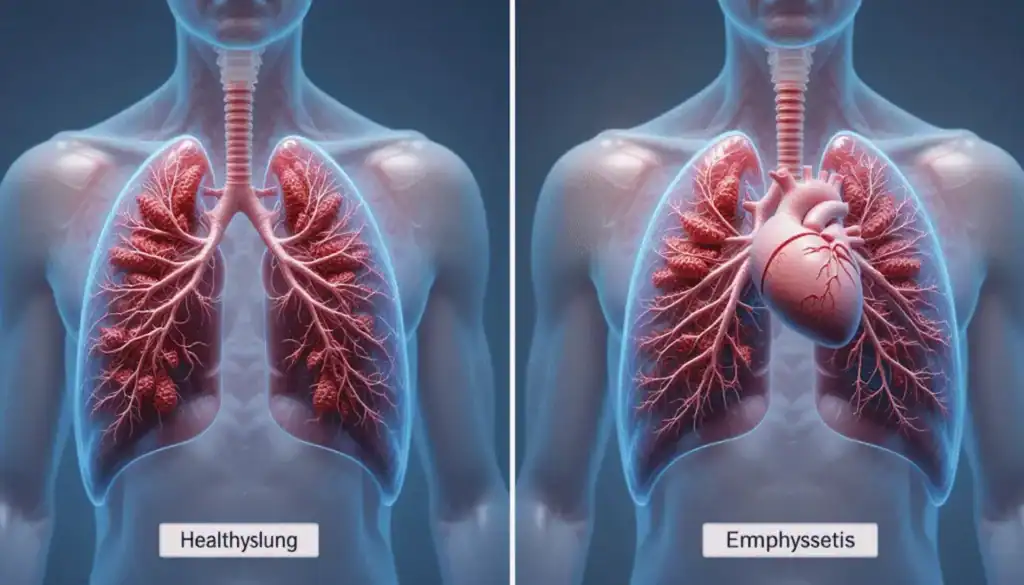Asthma is a chronic inflammatory disease of the airways marked by reversible airway obstruction, bronchial hyperresponsiveness, and inflammation. It affects millions worldwide and, if uncontrolled, can severely impact quality of life.
In this article, we’ll break down asthma’s clinical features, classification, diagnosis methods, and treatment options — from mild intermittent symptoms to severe persistent asthma.
🔬 What Is Asthma?
Asthma is characterized by:
- Reversible airflow obstruction (unlike COPD, which is often irreversible)
- Bronchial hyperreactivity (sensitive airways)
- Episodic inflammation that leads to wheezing, breathlessness, and cough
Normal bronchioles are wide open and healthy. In asthma, these tubes become inflamed, swollen, and constricted, often due to a specific trigger.
🌬️ Types and Triggers of Asthma
1. Extrinsic (Allergic) Asthma
- Triggered by pollen, dust mites, pet dander, mold, smoke, etc.
- Often seen in people with atopy (genetic tendency for allergies)
- Common in children
- Generally has a better prognosis
2. Intrinsic (Non-Allergic) Asthma
- Triggered by viral infections, cold air, exercise, GERD, or medications (e.g., beta blockers, NSAIDs)
- More common in adults
- Can be more severe and persistent
🚭 Note: Exposure to second-hand smoke increases asthma risk, especially in children.
🩺 Symptoms of Asthma
- Persistent dry cough
- Shortness of breath
- Chest tightness
- Wheezing (especially expiratory wheeze)
- Symptoms worsen at night or early morning
- Lung percussion may reveal hyperresonance
Listen to wheezes via stethoscope — these are high-pitched, musical sounds due to narrowed airways.
🧪 Diagnosing Asthma
✅ Clinical Evaluation:
- Typical symptoms (dry cough, chest tightness, wheeze)
- Episodic or reversible symptoms
✅ Pulmonary Function Tests (PFTs):
- Spirometry is the main test.
- ↓ FEV₁/FVC ratio confirms obstructive pattern
- Reversibility after bronchodilator (e.g., albuterol) confirms asthma:
- ↑ ≥12% in FEV₁ = diagnostic
✅ Bronchial Provocation Test:
- Uses methacholine challenge to provoke asthma
- Not routinely done due to risk of severe bronchoconstriction
- Used when spirometry is normal but asthma is suspected
✅ Peak Expiratory Flow Monitoring:
- Home tool to assess airway function
- Useful for both diagnosis and follow-up
🗂️ Classification of Asthma
| Type | Daytime Symptoms | Nighttime Awakenings | FEV₁ % Predicted | Interference with Activity |
|---|---|---|---|---|
| Intermittent | ≤2 days/week | ≤2 nights/month | ≥80% | None |
| Mild Persistent | >2 days/week | 3–4 nights/month | ≥80% | Minor limitation |
| Moderate Persistent | Daily | >1 night/week | 60–80% | Some limitation |
| Severe Persistent | Throughout the day | Nightly | <60% | Extremely limited |
💊 Asthma Treatment by Severity
1. Intermittent Asthma
- Rescue Inhaler (SABA) only
- Example: Albuterol 90 mcg/puff, 2–4 puffs as needed
- No daily medications required
- In 2020, GINA guidelines recommended low-dose ICS even in intermittent asthma
2. Mild Persistent Asthma
- Daily low-dose ICS (e.g., budesonide, fluticasone)
- Alternatives: Montelukast, Zafirlukast (leukotriene receptor antagonists)
- Continue SABA as needed
3. Moderate Persistent Asthma
- Daily combo inhaler: Low-dose ICS + Long-acting β₂ agonist (LABA) like formoterol
- Use the same inhaler as a rescue as well
- Alternatives:
- ICS + LAMA (e.g., tiotropium)
- ICS + Montelukast
- Never use LABA alone!
4. Severe Persistent Asthma
- High-dose ICS + LABA + LAMA
- Add oral corticosteroids (if not controlled)
- Continue SABA as rescue
- Consider biologic agents if resistant to treatment
✅ General Measures
- Avoid NSAIDs, beta blockers, allergens, and smoke
- Use allergen-proof bedding
- Manage comorbidities like GERD, obesity
- Educate patient on proper inhaler use
- Consider spacers to ensure drug delivery
- Use peak flow meters at home for monitoring
📆 Follow-Up Plan
- Reassess in 2–4 weeks
- Monitor:
- Symptom frequency
- Rescue inhaler usage
- PFT results
- Consider step-down if well controlled for 3+ months
- If worsening: Evaluate compliance, inhaler technique, triggers
⚠️ Common Drug Side Effects
| Drug Class | Side Effect |
|---|---|
| Inhaled Steroids | Oral candidiasis (rinse mouth) |
| Beta-Agonists | Tremors, palpitations |
| Oral Steroids | Hyperglycemia, osteoporosis, cataracts, adrenal suppression |
🕰️ Fun Historical Fact
In the past, Grimault’s cigarettes were advertised for asthma relief — containing atropine, cannabis, and even datura. Today, we know tobacco worsens asthma — and smoking cessation is the most important lifestyle change for asthmatics.
🧠 Summary
- Asthma is a chronic, reversible airway disease
- Diagnosed by clinical symptoms + spirometry
- Treatment is step-wise, tailored by severity
- ICS + LABA is mainstay for persistent asthma
- Patient education, lifestyle changes, and compliance are key



